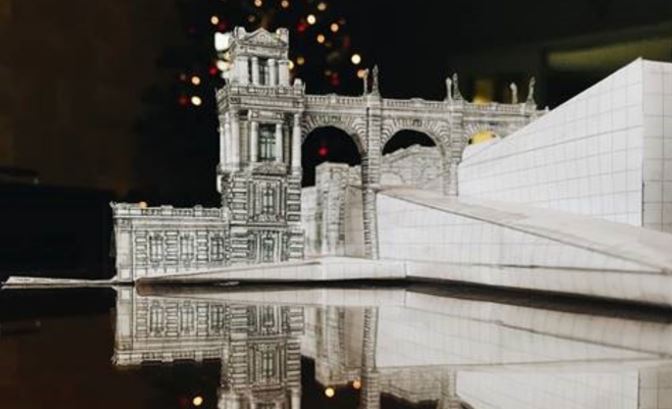- Daily & Weekly newsletters
- Buy & download The Bulletin
- Comment on our articles
Architects pitch 'hypothetical' projects to replace Marolles escalator
The lift which connects the Brussels courthouse to the Marolles district below is a divisive feature of the capital’s cityscape.
Some people have long complained that the grey and white tower is an ugly distraction from the imposing and monumental Palais de Justice, despite the courthouse itself appearing less magnificent for the past 40-odd years due to its omnipresent scaffolding. Others consider it to be one of the city’s most recognisable landmarks; an oddity but one which is seen as typically Bruxelloise in its indifference to opinion and taste.
The lift itself has stood in the face of these divided opinions for 20 years, with only a few breakdowns since its 2002 inauguration blemishing its almost perfect record of service. Despite this, a proposal to replace the elevator with something prettier has been put forward by the Round Table of Architecture, an association dedicated to promoting urban planning projects.
The international competition to solicit designs for replacement designs was launched in November. Architects from all over the world submitted projects and the three winners have just been chosen, following a vote on social networks.

The project that received the most votes is that of Sean Rhine, a German architect " whose elevator project is in line with the style of the Palais de Justice and elegantly spans the Poelaert ramp to drop travellers into the medieval heart of the Marolles", explains the Round Table of Architecture in a press release.
The association’s Noé Morin was won over by Rhine’s design. "This project fully respects the style and architecture of the courthouse,” he said. “It is a kind of architectural extension of the latter, and it is all the more effective as the materials proposed are the same as for the courthouse, namely the use of blue stone.”

Another German project, from architect Martin Pawlik, took second place in the competition. His design also utilises arches, but the style is totally different. "It is reminiscent of the Italian Renaissance, in particular with red bricks as a material," said Noé Morin. This aesthetic is also followed in the design of the lift’s tower which would not look out of place in Florence, Pisa or Siena.
A Belgian project, submitted by Bart Baudonck, took third place. Baudonck’s vision is based on the designs of the 19th century with echoes of Art Nouveau, the Eiffel Tower or the huge, glazed warehouses with metal structure which were typical of this era. In this design, the walkway to access the lift would be a bridge of sorts with wrought iron sides and adorned with old-fashioned lampposts.

It may have been labelled a competition but, according to Morin, there was no prize money or promise that the designs would ever be used to replace the current elevator. “What we offer the participants is, first of all, an opportunity to make themselves known,” he said.
“Some are students, others want to promote their work in Europe, as they come from elsewhere in the world. Finally, there is a desire among many of them to work on a voluntary basis to beautify cities. And in Brussels, there is a lot of work to be done at this level. This also serves to show the inhabitants, the people of Brussels, that there are alternatives to the damage caused by ‘Brusselisation’, specifically the large concrete towers which were created in the 1960s."
For this competition, the association did not impose a limit on the theoretical cost of the project. "On the other hand, we attach great importance to asking them to use local materials, which can be easily found, and for not too expensive, in Belgium or Brussels,” continued Noé Mori.
“Here, if we want to carry out one of the three winning projects, in my opinion, we won't exceed a budget of a few million euros. When we sometimes see the buildings that are being built in Brussels or elsewhere with much higher budgets, we say to ourselves that these projects would no doubt also have their place in the public space.".
The association regularly launches this kind of online architectural competition to propose alternatives to existing spaces or buildings, not only in Brussels, but also in Namur, Liège or Antwerp.
The projects themselves offer a glimpse at a more beautiful future for the Marolles lift but no one should get too carried away quite yet. For the moment, there is no plan at government level to replace it.














